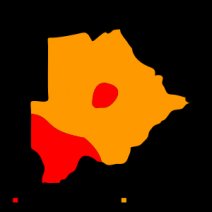Botswana Environmental Issues
Botswana is currently facing two major environmental problems: drought and desertification. The desertification problems predominantly stem from the severe times of drought in the country. Due to the drought 75% of the country’s human and animal populations are dependent on groundwater. Groundwater use has eased the effects of drought, but has left a toll on the land. Groundwater is retrieved through drilling deep boreholes, which leads to the erosion of the land.[4] Surface water is very scarce in Botswana and less than 5% of the agriculture in the country is sustainable by rainfall.[4] Due to this 95% of the country raises cattle and livestock as a means for an income. Therefore, it is not a surprise to see that 71% of the country’s land is used for communal grazing, which has been a major cause for the desertification of the country.
In terms of desertification, Botswana is one of the most seriously affected countries in the Kalahari
Region of Southern Africa. Problems include overstocking, large-scale vegetation depletion and
changes, especially around water points, and accelerated soil erosion by wind, sheetwash and gullying.
Part of the desertification problem is natural in such a semi-arid and drought-prone environment.
But the greater part is due to pressure of commercial exploitation of a fragile ecosystem. Owing to the
increasing pressure of the already crowded communal grazing areas of the east, owners of large herds
have, in the last three decades, been moving westwards, establishing permanent cattle posts in the
Kalahari sandveld and spreading conditions of overstocking and degradation of vegetation on a large
scale. The move into the Kalahari sandveld has been facilitated by the Tribal Grazing Lands Policy
(TGLP), introduced in 1975, which encouraged owners of large herds to move them out of the
crowded settlement areas, to the sandveld where they would be given exclusive rights to land to establish fenced commercial ranches. Impetus was also provided by the impact of modern science and
technology that provided veterinary care and new sources of water by means of deep drilling boreholes.
Recent satellite imagery reveals that there has been considerable uncontrolled development of
cattle posts in areas set aside for wildlife management, resulting in the emergence of land use conflicts










